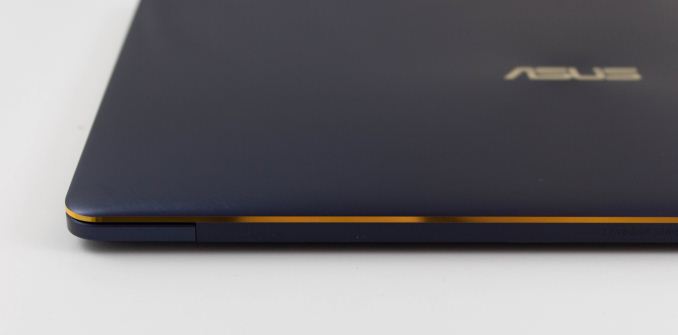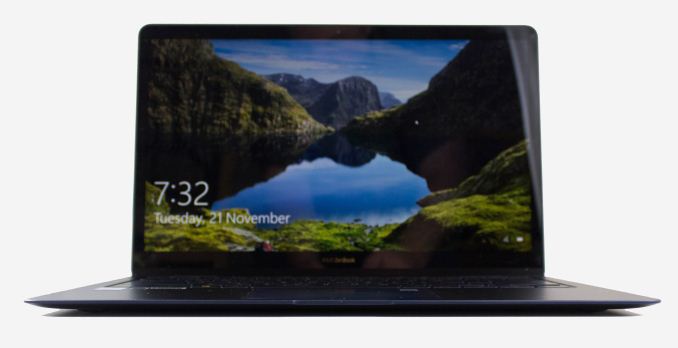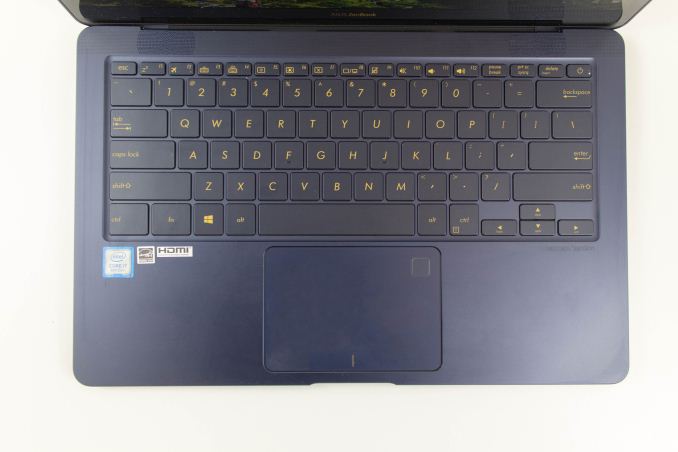The ASUS ZenBook 3 Review: A Convincing Case for Quad Core Thin & Light Laptops
by Brett Howse on November 22, 2017 8:00 AM EST- Posted in
- Laptops
- Asus
- Zenbook
- Core 8th Gen
- Kaby Lake Refresh
Design
ASUS has really refined their design over the last couple of years, and the ZenBook 3 is a great example of their work. The entire laptop is built out of aluminum, as you’d expect in a premium Ultrabook, and finished in either Royal Blue or Quartz Gray. The finish is nicely textured to provide a comfortable grip as well, but it is a bit of a fingerprint magnet. The compact design is highlighted by the very thin bronze strip on the outside of the display bezel, giving a nice contrast to the color of the finish.
ASUS has jumped on the thin-bezel bandwagon, and the 7.46 mm bezels on the sides really shrink the overall laptop. They’ve not gone quite as thin as Dell, especially on the top, but that does then leave room for the webcam in the proper position at the top of the display. ASUS states the screen-to-body ratio is at 84%. It’s really great to see larger displays like this 14-inch panel put into Ultrabooks that used to be 13.3-inch models. It’s a bit bigger than an XPS 13, but doesn’t feel much bigger thanks to the light weight.
Unlike some of their lower-cost ZenBooks, the ZenBook 3 features a fully backlit keyboard, and although the backlighting is handled by white LEDs, the amber key cap fonts give the keys a great level of contrast without overpowering your eyes in dim lighting. There is three levels of backlighting available.
The keyboard itself is pretty standard fare for ASUS, with a six-row keyboard that offers a fairly standard key layout. The arrow keys are half-height, but are separated enough that they work well. The only real concern with the keyboard is something that ASUS has been doing forever, which is placing the power key at the top right corner, above backspace. This can cause you to accidentally shut off the device when trying to correct text, which isn’t ideal. The key feel is decent, for a low-travel thin keyboard.
The trackpad is a Precision touchpad, featuring a glass surface. The trackpad is smooth and easy to use, and one of the best ones that ASUS has utilized. ASUS has also gone with a trackpad that features a built-in fingerprint reader, which is located in the top right corner. It’s a capacitive model, and quickly lets you get going with Windows Hello for a password-free login.
As for ports, ASUS has gone all-in on USB-C, outfitting the laptop with only USB-C ports. This is a bit awkward right now, as devices transition to the new, smaller, cable, but is as future-proof as a device can be at the moment. The laptop actually isn't even thick enough to support a USB-A port, so if you do need to access legacy devices you’ll have to use an adapter. Luckily ASUS has also outfitted two of the ports with Thunderbolt 3 support, while the third port is a standard USB 3.1 Gen 1 port, and all three USB-C ports support upstream charging. That means you can charge the ZenBook on any of the three USB-C ports, which is a nice touch, and avoids any confusion for the end-user.
The screen hinge is very nicely done, although you can’t quite open the laptop with one finger, but that’s also due to the light weight of the laptop. Unlike some other ASUS laptops we’ve reviewed, this hinge also doesn’t go over-center, meaning it doesn’t raise the back of the laptop off the desk. It doesn't open all the way to 180° like some devices, but in most scenarios that's not a huge deal for a non-touch laptop.
If you’re after a well-designed laptop, ASUS has really done a great job on the design of the ZenBook 3. It’s thin, light, and offers the modern benefits of a thin bezel and large display, but it does so with the traditional concentric circle aluminum design, and simply looks fantastic.
















55 Comments
View All Comments
aeronatis - Wednesday, November 22, 2017 - link
I believe they prefer to implement LPDDR to be able to reach long battery runtime during sleep. With standart DDR, any sleeping computer is pretty much out of juice overnight whereas laptops with LPDDR can sleep for days.DanNeely - Wednesday, November 22, 2017 - link
I've been able to sleep Dell Latitudes used by my previous employer over the weekend since the 2008(?) models; AFAIK all of them used standard DDR2/3 not low power sorts.hybrid2d4x4 - Thursday, November 23, 2017 - link
Overnight? That's a pretty major exaggeration. I had a Acer 3830TG (Sandy bridge, 4GB DDR3) that lasted >3 weeks in sleep. And before anyone says it, I always "powercfg -h off" on a new system/OS install.wolrah - Wednesday, November 22, 2017 - link
@labrats5 Who said anything about LPDDR3?@Jimios basically I'm looking for a powerful, portable machine on which to run VMs and do development. It'll never run games or even Windows so an nVidia or AMD GPU is just wasted silicon, wasted power, and annoying driver problems. I'd rather just use the Intel GPU that's built in to the processor and has great Linux support, but basically every proper workstation laptop forces a Quadro on you.
If I want to avoid the GPU I'm stuck looking at the thinner models. I don't really care about thin, I think my 2008-era Macbook Pro (the one right before unibody, that was basically an evolution of the Powerbook G4 design) was perfect as far as size/weight goes.
Jimios - Wednesday, November 22, 2017 - link
Can't the dGPU be completely disabled through BIOS/EFI or something? I haven't owned a non-Apple laptop recently so I honestly don't know.As for your use case (multiple VMs, etc.), I understand, but I don't think there would be too much demand for what you're asking. A laptop with your description wouldn't sell well to justify the development and marketing cost, IMO. Laptops like the article we're commenting on are mass market devices.
Also, typically with "workstation laptops" companies aim at CAD/CAM engineers and creative professionals. Which is sad, and I understand your frustration.
DanNeely - Wednesday, November 22, 2017 - link
As a developer currently using a Yoga with 16GB of ram, while I'd rather have a big laptop with a 45W CPU and 32GB of ram; if I could only have 1 I'd go for the ram multiple VMs or copies o Visual studio and a bunch of loaded browsers max out 16GB more often than I'm CPU limited.wolrah - Wednesday, November 22, 2017 - link
"Can't the dGPU be completely disabled through BIOS/EFI or something? I haven't owned a non-Apple laptop recently so I honestly don't know."I have yet to encounter a dual-GPU laptop where all the video ports were wired through the onboard GPU. Usually at least one of the external ports and sometimes the internal display is wired through the dedicated component, requiring that part to be enabled for those ports to work.
On my current Asus with a GT650M the HDMI port is wired through the nVidia chip so if I want to use an external monitor I have to either use VGA (yuck) or deal with the disaster that is nVidia Optimus. Even under Windows it's annoying, under Linux it's a mess.
linuxgeex - Thursday, November 23, 2017 - link
I've felt the same as you for the last decade, but you'd be surprised these days. AMD GPUs are quite well supported out of the box on open drivers, within 6mo of launch, and generally you can get them up on launch day using recent kernel/Mesa releases. I'll be getting an AMD 2500u based laptop this time around. Probably the Acer Swift.timecop1818 - Thursday, November 23, 2017 - link
> basically I'm looking for a powerful, portable machine on which to run VMs and do development. It'll never run games or even Windows so an nVidia or AMD GPU is just wasted silicon, wasted power, and annoying driver problems. I'd rather just use the Intel GPU that's built in to the processor and has great Linux support, but basically every proper workstation laptop forces a Quadro on you.you had me until "never runs Windows", lol.
nice troll, bro, nice troll.
also, accelerated graphics support in lunix. ha ha ha ha ha.
thanks for the laugh.
IGTrading - Wednesday, November 22, 2017 - link
It will be lovely to watch AMD Ryzen Mobile mop the floor with this 1700 USD waste of money.For this much money, I would expect way better performance, but luckily HP Envy x360z with Ryzen Mobile is just 600 USD.
There's nothing in ASUS' new Zen that's worth the extra 1000 USD they're asking.